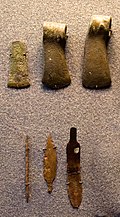Catacomb culture
The Catacomb culture, ca. 2800-2200 BC, refers to an early Bronze Age culture occupying essentially what is present-day Ukraine. It was related to the Yamna culture, and would seem more of an areal term to cover several smaller related archaeological cultures.
Economy and burial rites
The name comes from its burial practices. These are similar to those of the Yamna culture, but with a hollowed-out space off the main shaft, creating the 'catacomb'. Animal remains were incorporated into a small minority of graves.
In certain graves there was the distinctive practice of what amounts to modelling a clay mask over the deceased's face, creating an obvious if not necessarily correct association to the famous gold funeral mask of Agamemnon (see also Tashtyk culture).
The economy was essentially stockbreeding, although traces of grain have been found. There seem to have been skilled specialists, particularly metal-workers, however.
Origin and demise
The origin of the Catacomb Culture is disputed. Jan Lichardus[1] enumerates three possibilities: a local development departing from previous the Yamna Culture only, a migration from Central Europe or an oriental origin. The culture is first to introduce corded pottery decorations into the steppes and shows a profuse use of the polished battle ax, providing a link to the West. Parallels with the Afanasevo culture, including provoked cranial deformations, provide a link to the East.
The Catacomb culture was ousted by the Srubna (Timber-grave) culture from ca. the 17th century, associated with an Iranian expansion or with the Cimmerians (variously classified as either Iranian, Thracian or (formerly) Celtic).
Language
The linguistic composition of the Catacomb culture is unclear. Within the context of the Kurgan hypothesis expounded by Marija Gimbutas, an Indo-European component is hard to deny, particularly in the later stages. Placing the ancestors of the Greek, Armenian and Paleo-Balkan dialects here is tempting, as it would neatly explain certain shared features.
More recently, the Ukrainian archaeologist V. Kulbaka has argued that the Late Yamna cultures of ca. 3200-2800 BC, esp. the Budzhak, Starosilsk, and Novotitarovka groups, might represent the Greek-Armenian-"Aryan"(=Indo-Iranian) ancestors (Graeco-Aryan, Graeco-Armenian), and the Catacomb culture that of the "unified" (to ca. 2500 BC) and then "differentiated" Indo-Iranians.
Grigoryev's (1998) version of the Armenian hypothesis connects Catacomb culture with Indo-Aryans, because catacomb burial ritual had roots in South-Western Turkmenistan from the early 4th millennium (Parkhai cemetery).
Artifacts
 |
 |
 |
 |
Footnotes
- ^ Jan Lichardus - La protohistoire de l'Europe, 1987, Book 1 Chapter III:III.1.A
Sources
- Grigoryev, S.A. (1998), "The Sintashta Culture And Some Questions Of Indo-European Origins" (PDF), Proceedings Of The Chelyabinsk Scientific Center, no. 2 (published October–December 1998), pp. 82 ff.
{{citation}}: CS1 maint: date format (link). - V. Kulbaka, "Indo-European populations of Ukraine in the paleometallic period", Mariupol 2000. ISBN 966-7329-30-5
- Mallory, J. P. (1997), "Catacomb Culture", Encyclopedia of Indo-European Culture, Fitzroy Dearborn.
See also
- Shaft grave
 Media related to Catacomb culture at Wikimedia Commons
Media related to Catacomb culture at Wikimedia Commons
